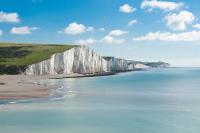The Opening of the King Charles III England Coast Path
Share this page
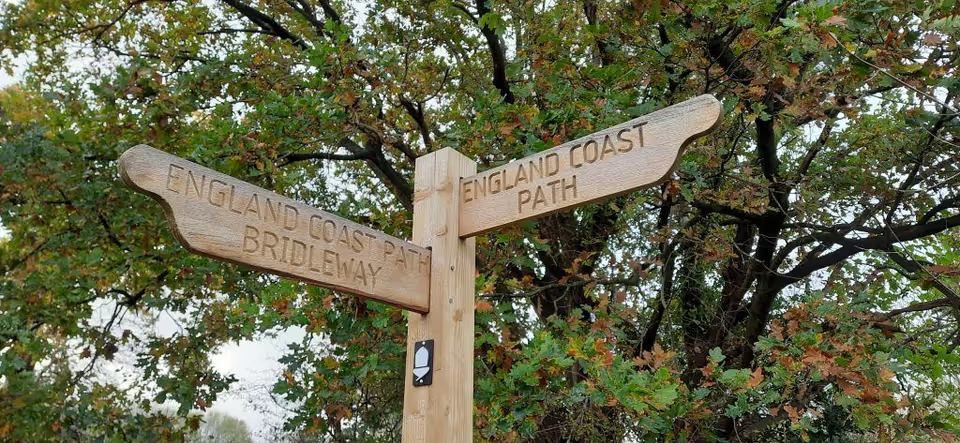
I had an impression that there was a continuous footpath that went round the whole coastline of Great Britain… Usually it was a muddy twelve-inch path, with a brisk figure approaching in plus-fours and thick-soled shoes and a crackling plastic mackintosh, and carrying a bag of sandwiches and an Ordnance Survey map. I imagined this person to be just another feature of the British coast, like old gun emplacements, and the iron piers, and the wooden groynes, and the continuous and circling footpath.
(Paul Theroux, The Kingdom by the Sea)
Despite Theroux’s impression, there has never until now been a continuous path around the coast of England. John Merrill famously walked nearly 7,000 miles around the whole coast of Britain in just 10 months in 1978, the first person known to do so, but this was his own bespoke route that in places required straying inland and in others involved trespassing. Others have followed parts of his journey over the years and several long distance routes have been promoted along the English coast, most notably the South West Coast Path. However, it was far from a complete circuit, with the more difficult parts around estuaries and through private estates avoided by these routes, making it hard to complete a meaningful circumnavigation without Merrill’s meticulous planning and sheer determination.
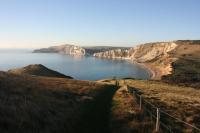
What is now rebranded as the King Charles III England Coast Path began with the Marine and Coastal Act 2009, which created a statutory duty for Natural England to establish a long distance trail around the whole coast of England and designate a coastal margin for open access to all beaches, cliffs and shoreline. These two parts have been worked on in tandem, meaning it is a far more complicated proposition than the Wales Coast Path, the 870-mile route around Wales that opened in 2012. One of the most powerful elements of the new legislation is the idea of ‘roll-back’, with the new coast path automatically moving inland as cliffs eroded or collapsed without the need for any further negotiations with landowners – this is particularly important in parts of the east coast where the land is disappearing at rates of up to 2m per year. At estuaries, discretion can be used to extend the trail along (and potentially beyond) any tidal waters as far as the first bridge or crossing with pedestrian access. As such, it represents a great opportunity to secure coastal access in areas where there previously was none, linking existing coastal trails and providing recreation benefits for residents, businesses and visitors alike.
The coast has been broken down into 67 sections, with statutory reports being created for each, recommending where the route should go and identifying a suitable coastal margin in each area. After a period of consultation, during which objections could be lodged, these reports were to be presented to the Secretary of State for Environment, Food and Rural Affairs for approval or amendment. Only then could work begin on the path itself, with each section declared open once signs, gates, bridges and other furniture had been installed by the relevant local authority.
The coastal margin is a single continuous corridor of all the land to the seaward side of the new trail and occasionally further areas of beach, dune or foreshore on the landward side. Any buildings and their immediate curtilage or gardens are automatically excluded, as well as Military Lands, railways, quarries, schools, racecourses, aerodromes, golf courses, burial grounds, caravan parks and any fields that have been cropped in the previous 12 months. Other areas may also be excluded, including those with statutory environmental designations like Marine Conservation Zones and Sites of Special Scientific Interest. These cover most of the estuaries and marshes of the country and, together with the above, exclude a lot of land, but what these new rights do ensure is still important. Any beach or stretch of non-designated foreshore can now be freely accessed by anyone on foot or by wheelchair for walking, climbing or picnicking, though these rights do not extend to camping, cycling or horse riding.
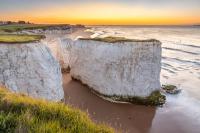

The England Coast Path - Book 1: The South Coast
£15.99A practical guidebook for walking over 700 miles of the England Coast Path from the River Thames to the River Exe. Starting in Woolwich and finishing in Exmouth, this book covers the coasts of Kent, Sussex, Hampshire, the Isle of Wight and Dorset.
Buy NowInitially it was estimated that the England Coast Path would take just a few years to establish, but cuts to Natural England’s budget and a reluctance by landowners to acquiesce to this new legislation hindered its progress. In 2014 the Coalition Government, in one of the Liberal Democrats’ few lasting legacies from their brief stint in power, pledged to allocate extra funding to deliver the completed route by 2020. This allayed fears that the path would become a victim of political vagaries and this great opportunity to change the face of the English coast would be lost, but of course it was never going to be as simple as the politicians thought.
By the end of 2020, just 387 miles of the England Coast Path was officially open with the new coastal access rights in place, approximately 14% of the whole route. For those of us working on books on this route and groups like the Ramblers and Long Distance Walkers Association, it was quite dispiriting. The first short section had opened in June 2012 between Weymouth and Lulworth Cove and I’d walked my first parts of the route in Durham and Cumbria soon after they opened in April 2014, but since then it has felt at times that things have progressed at a snail’s pace. Most of the work though was going on behind the scenes at Natural England, negotiating a route that satisfied both environmental bodies and local landowners. Continued budgetary restraints and a global pandemic haven’t helped, and we have had to keep the faith that the small team at Natural England could still deliver this huge national project.
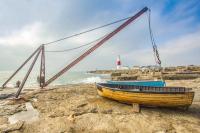
So here we are in 2023 (which is being proclaimed as the ‘Year of the Coast’) and the England Coast Path is still not yet complete, but there is enough of it ready in parts of the country for me to launch the first book in this series. The England Coast Path: Book 1 - The South Coast is the first in a series of four guidebooks, providing the most thorough information for walking the entire route. There is information on public transport, parking, accommodation, campsites, refreshments, and local history, as well as a song for each section of the route. Whether you’re walking the route in small sections or all in one go, this is the perfect companion to the England Coast Path.
The first book covers over 700 miles along the south coast of England from the River Thames in London to the River Exe at Exmouth. Tracing the coastlines of Kent, Sussex, Hampshire, Dorset and the Isle of Wight, this varied route takes in dizzying chalk cliffs, estuarine marshes, long beachfront promenades, densely wooded undercliffs and many more rewarding landscapes. There are still gaps that will hopefully soon be filled, but in these cases I have suggested the best route currently available at time of publication. If you find newly opened sections with clear signage, you should follow these, but in their absence I have provided the best available route I can. There are sections that are not yet signed as the England Coast Path and more care will be needed to stay on the route here, but hopefully my route descriptions are detailed enough to follow and, if in doubt, always keep the sea on your left!
